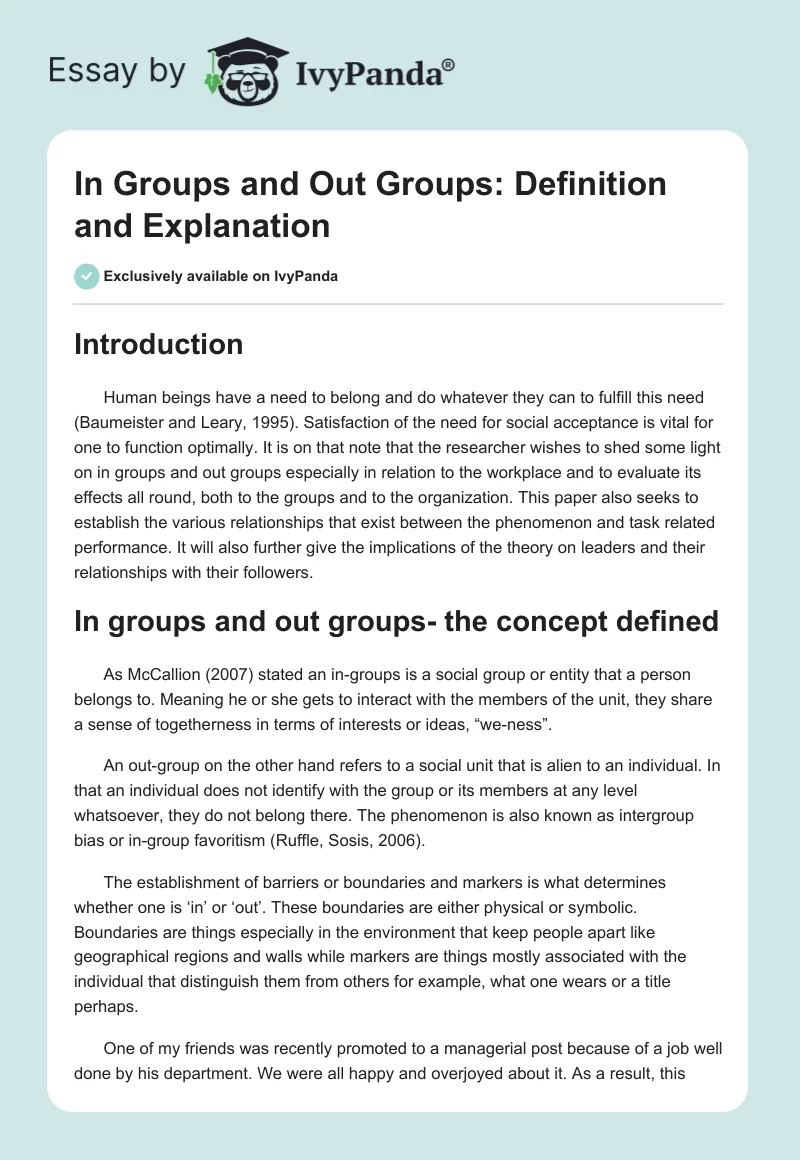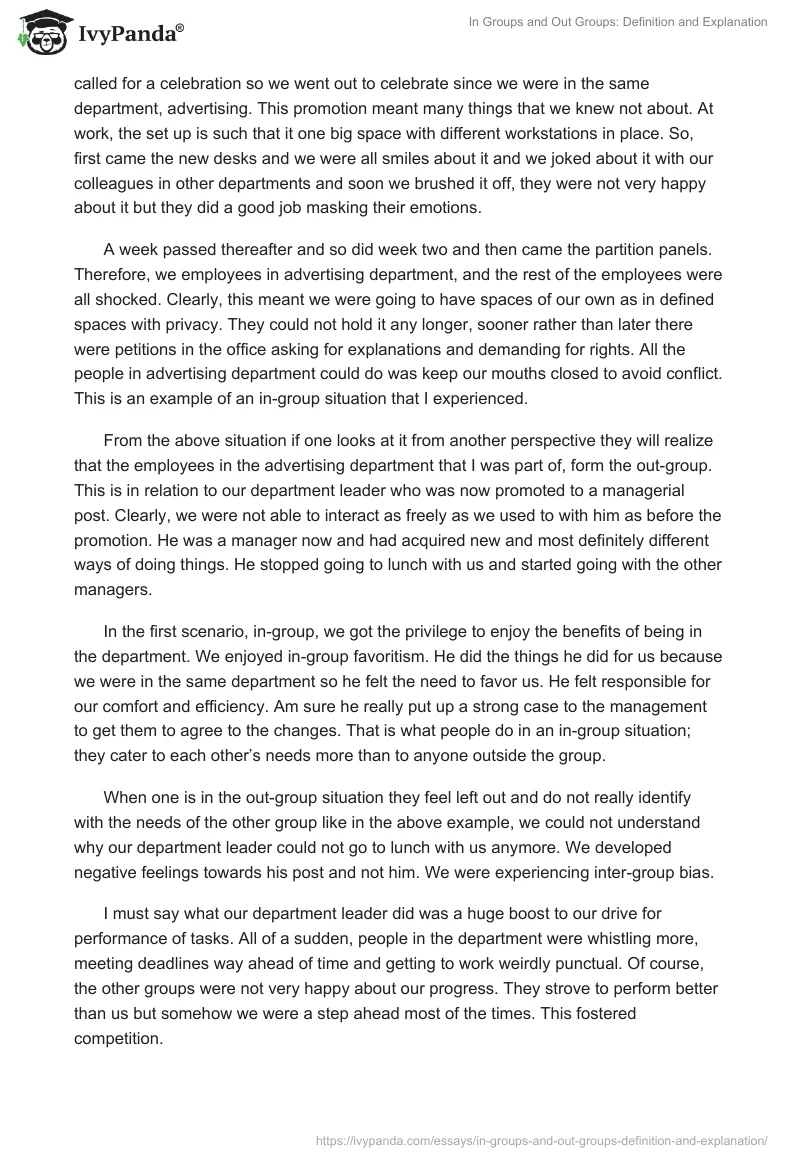Introduction
Human beings have a need to belong and do whatever they can to fulfill this need (Baumeister and Leary, 1995). Satisfaction of the need for social acceptance is vital for one to function optimally. It is on that note that the researcher wishes to shed some light on in groups and out groups especially in relation to the workplace and to evaluate its effects all round, both to the groups and to the organization. This paper also seeks to establish the various relationships that exist between the phenomenon and task related performance. It will also further give the implications of the theory on leaders and their relationships with their followers.
In groups and out groups- the concept defined
As McCallion (2007) stated an in-groups is a social group or entity that a person belongs to. Meaning he or she gets to interact with the members of the unit, they share a sense of togetherness in terms of interests or ideas, “we-ness”.
An out-group on the other hand refers to a social unit that is alien to an individual. In that an individual does not identify with the group or its members at any level whatsoever, they do not belong there. The phenomenon is also known as intergroup bias or in-group favoritism (Ruffle, Sosis, 2006).
The establishment of barriers or boundaries and markers is what determines whether one is ‘in’ or ‘out’. These boundaries are either physical or symbolic. Boundaries are things especially in the environment that keep people apart like geographical regions and walls while markers are things mostly associated with the individual that distinguish them from others for example, what one wears or a title perhaps.
One of my friends was recently promoted to a managerial post because of a job well done by his department. We were all happy and overjoyed about it. As a result, this called for a celebration so we went out to celebrate since we were in the same department, advertising. This promotion meant many things that we knew not about. At work, the set up is such that it one big space with different workstations in place. So, first came the new desks and we were all smiles about it and we joked about it with our colleagues in other departments and soon we brushed it off, they were not very happy about it but they did a good job masking their emotions.
A week passed thereafter and so did week two and then came the partition panels. Therefore, we employees in advertising department, and the rest of the employees were all shocked. Clearly, this meant we were going to have spaces of our own as in defined spaces with privacy. They could not hold it any longer, sooner rather than later there were petitions in the office asking for explanations and demanding for rights. All the people in advertising department could do was keep our mouths closed to avoid conflict. This is an example of an in-group situation that I experienced.
From the above situation if one looks at it from another perspective they will realize that the employees in the advertising department that I was part of, form the out-group. This is in relation to our department leader who was now promoted to a managerial post. Clearly, we were not able to interact as freely as we used to with him as before the promotion. He was a manager now and had acquired new and most definitely different ways of doing things. He stopped going to lunch with us and started going with the other managers.
In the first scenario, in-group, we got the privilege to enjoy the benefits of being in the department. We enjoyed in-group favoritism. He did the things he did for us because we were in the same department so he felt the need to favor us. He felt responsible for our comfort and efficiency. Am sure he really put up a strong case to the management to get them to agree to the changes. That is what people do in an in-group situation; they cater to each other’s needs more than to anyone outside the group.
When one is in the out-group situation they feel left out and do not really identify with the needs of the other group like in the above example, we could not understand why our department leader could not go to lunch with us anymore. We developed negative feelings towards his post and not him. We were experiencing inter-group bias.
I must say what our department leader did was a huge boost to our drive for performance of tasks. All of a sudden, people in the department were whistling more, meeting deadlines way ahead of time and getting to work weirdly punctual. Of course, the other groups were not very happy about our progress. They strove to perform better than us but somehow we were a step ahead most of the times. This fostered competition.
In-group and out-group situations at work places may give rise to a strain in relationships. This in the sense that, the negative feelings may develop to extreme cases of racism and prejudice. This may not be noticeable at first since in its mild stages the negative feelings between the teams may pass off as distrust or even a sense that the other team does not deliver as well as theirs does.” Sumner stressed the negative reciprocity between in-groups and out-groups, especially in the context of conflict over scarce resources” his statement sums it all up (Sumner , 2007).
This causes divisions in the organization that may lead to instability since the decisions will now take longer to make because some may oppose just to be different from the other teams. A brighter side of such a situation might be increased productivity in the early stages when it is all about outsmarting other groups. The competition might be very healthy for the organization to some extent. Sumner attested to this fact when he said, ” In an environment of scarcity, individuals need to band together to compete with other groups” (Sumner , 2007). The management should know when to stop to avoid ugly consequences.
In any organization, forming of groups is always about task performance and so was our department it was about who was good at advertising. Good at interpreting and representing ideas in the most effective way, this was how the group was formed. However, when it came to enjoying benefits it was more about everyone being proud of being in the department whether one delivered in the particular victory or not.
Leaders in any company should be careful not to build walls between them and their employees or, even between employees. They can start by making sure they remove boundaries in offices for example anything that creates partitions be it panels or cupboards. Removing anything that keeps one section of a team from the others in any way and placing all the teams dealing in projects in the same office. The management can also get rid of all markers for example status symbols and team badges.
They can also focus on fostering healthy individual relationships between the employees to dissolve the boundaries and markers. They can do this by organizing social trips and events so they can bond outside the uptight work atmosphere. In the same spirit to establish a common ground they can introduce measures that unify the different teams for example same t-shirt printed in the same way for all members.
Creating awareness on the effect of in/out groups to the team members and educating them on how to counter it can go ahead a great deal in preventing unfavorable outcomes. This can be achieved further by teaching them to embrace the opinions and ideas that people of various markers or situations bring to the table.
Conclusion
In conclusion, in/out groups influence both positively and negatively to any organization. Managements should seek to maximize on the positive by removing markers and boundaries. They should also encourage members to bond more so they stop concentrating on being against each other and complement each other more. Most important of all, they should educate members on the implications of letting this phenomenon get the best of them so they can be more accommodating.
Reference
Friedman & Gil. (2006). Insights from Sociology’s In-Group-Out-Group Hypothesis for the Explanation of Rallying-Round-the-Flag and Diversionary Force. Web.
Krill, A., & Platek, S.M. (2009). In-Group and Out-Group Membership Mediates Anterior Cingulate Activation to Social Exclusion. Web.
McCallion, M.J. (2007). In-Groups and Out-Groups. Doi: 10.1111/b.9781405124331.2007.x
Ruffle, B. J, & Sosis, R. (2006). Cooperation and the in-group-out-group bias: A field-test on Israeli kibbutz members and city residents. Journal of Economic Behavior & Organization. Vol. 147–163.
Team Technology. (n.d.). Team islands. 2010. Web.


